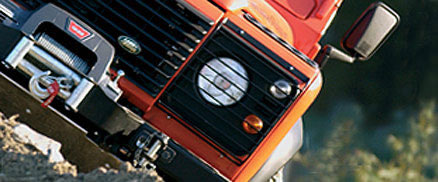October 23rd, 2010
Driving on soft sand is not the easiest thing to do but with some preparation and safety tips can be an enjoyable and fun experience in your 4×4.
- As soon as the surface gets softer than a road select the 4×4 drive. Then, when leaving the sand, don’t forget to switch the 4×4 off again. If you don’t do that, it will put stresses on the driveshaft, gearbox and transfer cases as well as cause unnecessary and uneven tyre wear.
- Always reduce the tyre pressure just before going on the sand. This will influence your vehicle performance as the more air you let out, the more tyre will be on the sand, and the better flotation you’ll get.
- If you are afraid to drive on the soft sand, drive on the hard sand just next to the water. It’s worth remembering, though, that patches of soft sand might be found everywhere.
- One of the most common mistakes while driving on sand is to use high gear without leaving any reserve. This will most probably caught you stuck in the sand. If you use lower gear, you can respond more quickly.
- If you start getting stuck, don’t rev the power and dig a bigger hole. Try to stop the vehicle and reverse out on a fresh track.
- Drive off slowly only if all four wheels are safe on the firm sand.
- Try to avoid driving your 4×4 in the sea. It will deteriorate your vehicle quickly even if you give it a rinse afterwards. Another thing is you can sink easily when you stop in the water.
Posted in Arbil 4x4 |
October 3rd, 2010
Lifting beams, frames and spreaders are usually designed and built
for a specific purpose. The range of designs and capacities is therefore only limited by practicality. When selecting the beam to be used you need to plan the lift taking the following into account:
Application requirements:
- to reduce headroom, provide multiple lift points,
- to provide adjustable lifting centres,
- to handle out of balance loads,
- to remove or control inward or crushing forces, to allow for special load attachments.
Capacity, both of the overall beam and of the individual lift points.
Accessories and attachments – slings, grabs, shackles, hooks etc.
USING LIFTING BEAMS SAFELY
- Lifting beams may incorporate various loose and detachable items of lifting gear. Refer to the separate requirements for the safe use of those items.
- Do not use defective or distorted beams or attachments.
- Lifting beams are generally designed for a specific purpose and should not be used for other purposes without consulting the supplier. This will include the size of crane hook from which they are suspended. On no account should lifting beams be suspended from unsuitable size hooks.
- The weight of the beam, together with its attachments, must be added to the weight of the load when calculating the total load that will be imposed on the crane hook.
- Ensure that the SWL on the individual lift points is not exceeded. Extra care is needed where these are adjustable.
- Ensure the load is stable and that the beam remains at its intended attitude during use. Particular care is needed when lifting and setting down as not only may the load become unstable but individual lift points may become overloaded,
- Use tag lines to control long loads.
- Do not allow the beam to foul the underside of the crane, or any other obstructions, when raising or transporting loads.
Posted in Arbil Rail |
October 3rd, 2010
When you are out off roading you are prone to getting yourself stuck. Some common scenarios are described below with solutions of how to get yourself out of the jam.
High centred
This happens when something lodges under the vehicle and raises it causing traction to be removed from the wheels. This normally happens on off road tracks that have a high central ridge, crossing logs or where it sinks into sand.
To overcome this one technique is to completely back off. And carefully do it. If you have someone with you get them to lodge an object such as a rock or piece of wood underneath the spinning wheel. Another alternative would be to use a high jack lift which will put good footing underneath allowing you to drive off.
Getting stuck in sand
This often happens when the tyre is not wide enough to spread the actual load of the vehicle and/or the tread is too aggressive. If you’re off roading adventure is a desert crossing then it is advisable to have sand tyres fitted.
If you know your adventure will involve crossing sand then don’t forget to pack a long handled shovel. If you get stuck in sand then first off you need to jack up the wheels by piling sand underneath them and putting floor mats, carpet or whatever you have to hand under the wheels to provide the wheels with some grip. A good tip to know is if you have a pump then deflating air from the tyres so the pressure is reduced will help you get traction. Reduce the weight that is in the vehicle and drive out very very slowly.
Posted in Arbil 4x4 |
October 3rd, 2010
Two types of shackles that you can choose from are:
Anchor (bow type)
Chain (”D” type)
Both these types of shackles are used with screw or round pins. When selecting the right shackle, refer to manufacturers’ tables for the safe working loads of the shackles. Shackles are sized according to the diameter of the bow section rather than the pin size. Never use a shackle if the distance between the eyes is greater than listed in the manufacturers’ tables.
When it comes to inspecting shackles there are a few points that you should follow:
- Inspect shackles regularly.
- Inspect the shackle eye and pin holes for stretching (elongation) and wear. Elongation means the metal is being overloaded.
- Inspect the shackle body for bending. A bent shackle indicates excessive side-loading.
- Inspect all shackle pins for distortion, surface blemishes, wear and fractures.
- All pins must be straight and all screw pins must be completely seated. Cotter pins must be used with all round pin shackles.
- Replace shackles that are bent, show excessive wear by more than 10% of the original diameter, or have an elongated eye or shackle pin holes.
When using shackles you should avoid:
- Do not replace the shackle pin with a bolt or unidentified pins. A load will bend the bolt.
- Do not allow a shackle to be pulled at an angle. The legs will open. Pack the pin with washers to center the shackle.
- Do not use screw pin shackles or fit pins in contact with moving parts if the pin can roll and unscrew. If the load shifts, the sling will unscrew the shackle pin.
Posted in Arbil Lifting Gear |
September 2nd, 2010
To ensure safe and correct use of the Type B Trolley the following should be noted:
- Wear feet and hand protection when using the Type B Trolley. Additional Personal Protective Equipment (PPE) should be worn according to local regulations.
- The Type B Trolley, or parts of, must be replaced if damage occurs. Do not use the Type B Trolley if any components are damaged.
- Store the Type B Trolley in a secure position.
- LUL Type B Trolleys and other Type B Trolleys fitted with insulated wheels must not be used in locations where live AC overhead power lines are present. Do not use the Type B Trolley near live DC third-rail or fourth-rail systems.
- Ensure the Type B Trolley Sides are only used on a Permaquip™ Type B Trolley.
- Both halves of each trolley have the same serial number. Ensure they are kept together as one unit.
- Before using, undertake a Manual Handling Risk Assessment and follow the assessment guidelines at all times. Use the Brake and Push Handles provided. Do not exceed walking pace, noting underfoot and rail head conditions. Do not walk on sleepers or the rail head.
- Stopping distances will greatly increase by icy or wet conditions; gradients; an increase in load; an increase in speed.
- Do not allow any load protrusions to face downwards such that they could interfere with the braking mechanism.
- Do not ride on or tow the Type B Trolley.
- Do not use the Type B Trolley for any other purpose than as described in the introduction.
- Do not hold off the Brake Handle using mechanical means.
Posted in Arbil Rail |


